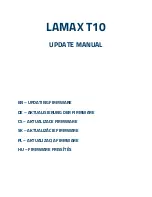
Appendices
11
11.1
Emissivity Factors for Common Materials
Material
Emissivity
Materia
l
Emissivity
Asphalt
0.90 ~ 0.98
Cloth (black)
0.98
Concrete
0.94
Skin (human)
0.98
Cement
0.96
Leather
0.75 ~ 0.80
Sand
0.90
Charcoal (powder)
0.96
Soil
0.92 ~ 0.96
Lacquer
0.80 ~ 0.95
Water
0.92 ~ 0.96
Lacquer (matt)
0.97
Ice
0.96 ~ 0.98
Rubber (black)
0.94
Snow
0.83
Plastic
0.85 ~ 0.95
Glass
0.90 ~ 0.95
Timber
0.90
Ceramic
0.90 ~ 0.94
Paper
0.70 ~ 0.94
Marble
0.94
Chromium Oxides
0.81
Plaster
0.80 ~ 0.90
Copper Oxides
0.78
Mortar
0.89 ~ 0.91
Iron Oxides
0.78 to 0.82
Brick
0.93 ~ 0.96
Textiles
0.90
11.2
IR Energy and Imaging Overview
A thermal imager generates an image based on temperature differences. In a
thermal image the hottest item in the scene appears as white and the coldest
item as black, and all other items are represented as a gray scale value be-
tween white and black. It may take some time to get used to the thermal im-
agery. Having a basic understanding of the differences between thermal and
daylight cameras can help with getting the best performance from the camera.
One difference between thermal and daylight cameras has to do with where
the energy comes from to create an image. When viewing an image with an
ordinary camera, there must be some source of visible light (something hot,
such as the sun or lights) that reflects off the objects in the scene to the cam-
era. The same is true with human eyesight; what people see is based on re-
flected light energy. On the other hand, the thermal imager detects energy
that is directly radiated from objects in the scene. Therefore, hot objects such
as parts on an engines and exhaust pipes appear white, while the sky,
#NAS100014; r. AA/59807/59807; en-US
30
www.
GlobalTestSupply
.com
Find Quality Products Online at:


































